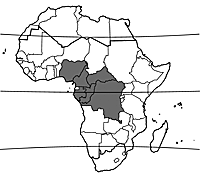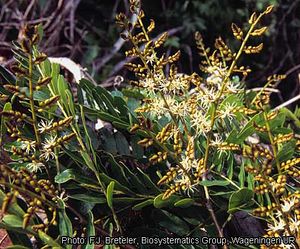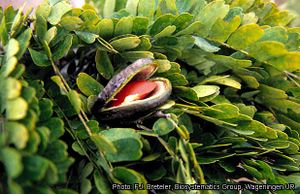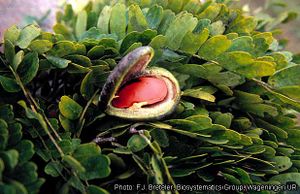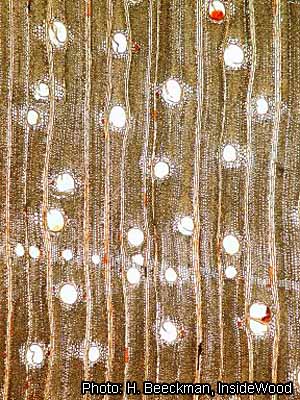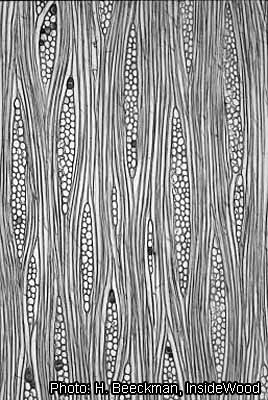Copaifera mildbraedii (PROTA)
Introduction |
| General importance | |
| Geographic coverage Africa | |
| Geographic coverage World | |
| Essential oil / exudate | |
| Medicinal | |
| Timber | |
| Fuel | |
Copaifera mildbraedii Harms
- Protologue: Notizbl. Bot. Gart. Berlin-Dahlem 8: 147 (1922).
- Family: Caesalpiniaceae (Leguminosae - Caesalpinioideae)
Origin and geographic distribution
Copaifera mildbraedii is distributed from south-eastern Nigeria eastward to the Central African Republic and southward to Gabon and DR Congo.
Uses
The wood of Copaifera mildbraedii, traded as ‘andem-eviné’ and ‘anzem noir’ and as ‘etimoe’ together with that of Copaifera salikounda Heckel, is mainly used for veneer. It is suitable for heavy construction, joinery, ship building, vehicle bodies, furniture, musical instruments, boxes, crates, carving and draining boards. It is also used as firewood.
Pygmy people in the Central African Republic use the bark in perfume. The fruit contains a resin that is inflammable. In the Central African Republic, fruits dried in the sun are used for lighting fires and they are burned in lamps and as candles. In traditional medicine in Nigeria, the fruits and seeds are used as purgative, stimulant and diuretic. In the Central African Republic, the bark is eaten to increase virility, bark decoctions are drunk or used in enemas or fumigations for the treatment of stomach problems, and a decoction of the bark of Copaifera mildbraedii and that of Anonidium mannii (Oliv.) Engl. & Diels is taken to cure female sterility.
Production and international trade
According to ATIBT statistics, Gabon exported 530 m³ of logs in 2001, 685 m³ in 2002, 235 m³ in 2003, 225 m³ in 2004 and 265 m³ in 2005. Congo exported 150 m³ of logs in 2004, and 80 m³ of logs and 100 m³ of sawn wood in 2006.
Properties
The heartwood is reddish brown, often with decorative streaks, and distinctly demarcated from the white or greyish white, up to 10 cm wide sapwood. The grain is straight, texture medium to fine and even. The wood contains resin.
The wood is moderately heavy, with a density of (600–)750–850 kg/m³ at 12% moisture content. Drying should be done slowly and with much care to prevent severe checks and distortion. It is advisable to quarter-saw the wood before drying. The shrinkage rates are moderately high, from green to oven dry 6.0% radial and 8.5% tangential. Once dry, the wood is moderately stable in service.
At 12% moisture content, the modulus of rupture is 127–155 N/mm², modulus of elasticity 10,800–15,300 N/mm², compression parallel to grain 64–70 N/mm², cleavage 21.5–24.5 N/mm and Chalais-Meudon side hardness 4.0–6.0.
The wood works well with both machine and hand tools. It planes very well, and gives an attractive finish. It takes nails well. The wood is only moderately durable, being susceptible to stain and termite attack. The sapwood is susceptible to Lyctus attack. The heartwood is extremely resistant to impregnation with preservatives.
The wood contains 40% cellulose, 30.5% lignin, 18% pentosan and 0.5% ash. The solubility is about 5.5% in alcohol-benzene, 2.7% in hot water and 27.1% in a 1% NaOH solution. Wood fibre cells in samples from DR Congo were on average 1.4 mm long and 20 μm wide, with a cell wall thickness of 4 μm and a lumen width of 12.5 μm.
Description
- Evergreen, large to very large tree up to 60(–65) m tall; bole branchless for up to 30 m, straight and cylindrical, up to 200 cm in diameter, sometimes thickened and grooved at base, without buttresses; bark surface smooth to slightly fissured, dark grey, inner bark fibrous, hard, brittle, pinkish yellow, turning brown on exposure, aromatic; crown umbrella-shaped; twigs hairy but soon becoming glabrous.
- Leaves alternate, pinnately compound with 20–40 leaflets; stipules caducous; petiole and rachis 13–25 cm long, grooved above; petiolules 1–2 mm long, hairy; leaflets alternate or nearly opposite, oblong, 1.5–4(–6) cm × 1–2(–2.5) cm, base rounded and asymmetrical, apex rounded to notched, glabrous except for the midvein below, with translucent dots, pinnately veined with 14–20 pairs of lateral veins.
- Inflorescence a terminal or axillary raceme 8–30 cm long, with lateral spike-like branches 2–5 cm long, reddish hairy.
- Flowers bisexual, zygomorphic, white; pedicel c. 1 mm long, with 2 caducous bracteoles up to 2.5 mm long; sepals 4, ovate-lanceolate, 3–4 mm × 1–2.5 mm, 1 broader than other 3, acute, reddish hairy; petals absent; stamens 9–10, free, 5–6 mm long; ovary superior, sessile, hairy at one side, 1-celled, style c. 2.5 mm long.
- Fruit an obliquely oblong to elliptical or nearly globose pod 3–5 cm × 2.5–3.5 cm, leathery, glabrous, brownish black, often shiny and covered with resin droplets, dehiscent with 2 valves, 1-seeded.
- Seeds oblong, slightly flattened, 1–3 cm × 1–1.5 cm, black, with thin, orange-red, waxy aril.
- Seedling with epigeal germination; hypocotyl 3–7.5 cm long, epicotyl 4–9 cm long; first 2 leaves opposite.
Other botanical information
In Nigeria Copaifera mildbraedii fruits ripen in February.
Copaifera comprises about 40 species, of which about 35 occur in tropical America, 4 in Africa and 1 in tropical Asia. Copaifera seems closely related to Baikiaea, Detarium, Sindora and Tessmannia.
Ecology
Copaifera mildbraedii occurs in rainforest and gallery forest, also in secondary forest, rarely in periodically inundated localities.
Management
In the Central African Republic and Gabon, the minimum bole diameter allowed for harvesting is 70 cm. Logs do not float well in water and cannot be transported by river. They should be extracted rapidly from the forest or treated with a preservative to avoid attacks by fungi and insects.
Genetic resources
Copaifera mildbraedii is widespread and locally fairly common within its distribution area. There are no indications of overexploitation and Copaifera mildbraedii does not seem to be threatened by genetic erosion.
Prospects
In view of the limited durability of the wood, it is more suitable for interior than for exterior use. Small quantities of Copaifera mildbraedii timber are traded on the international market, mainly for veneer production. Although it is locally fairly common, information on local use of its timber in tropical Africa is lacking.
Major references
- Aubréville, A., 1970. Légumineuses - Césalpinioidées (Leguminosae - Caesalpinioideae). Flore du Cameroun. Volume 9. Muséum National d’Histoire Naturelle, Paris, France. 339 pp.
- Bolza, E. & Keating, W.G., 1972. African timbers: the properties, uses and characteristics of 700 species. Division of Building Research, CSIRO, Melbourne, Australia. 710 pp.
- Sallenave, P., 1955. Propriétés physiques et mécaniques des bois tropicaux de l’Union française. Centre Technique Forestier Tropical, Nogent-sur-Marne, France. 129 pp.
- Takahashi, A., 1978. Compilation of data on the mechanical properties of foreign woods (part 3) Africa. Shimane University, Matsue, Japan. 248 pp.
- Vivien, J. & Faure, J.J., 1985. Arbres des forêts denses d’Afrique Centrale. Agence de Coopération Culturelle et Technique, Paris, France. 565 pp.
Other references
- Aké Assi, L., Abeye, J., Guinko, S., Riguet, R. & Bangavou, X., 1985. Médecine traditionnelle et pharmacopée - Contribution aux études ethnobotaniques et floristiques en République Centrafricaine. Agence de Coopération Culturelle et Technique, Paris, France. 140 pp.
- Burkill, H.M., 1995. The useful plants of West Tropical Africa. 2nd Edition. Volume 3, Families J–L. Royal Botanic Gardens, Kew, Richmond, United Kingdom. 857 pp.
- CIRAD Forestry Department, 2009. Etimoe. [Internet] Tropix 6.0. http://tropix.cirad.fr/ africa/ etimoe.pdf. April 2011.
- Danforth, R.M. & Noren, P.D., 1997. Congo native fruits: twenty-five of the best fruits and nuts found in the rainforest and savanna areas of northwest Congo, Africa. Loko AF Program, Bangui, Central African Republic. 72 pp.
- de Saint-Aubin, G., 1963. La forêt du Gabon. Publication No 21 du Centre Technique Forestier Tropical, Nogent-sur-Marne, France. 208 pp.
- Istas, J.R., Raekelboom, E.L. & Heremans, R., 1959. Etude de quelques bois congolais. Série technique No 59. Institut National pour l’Etude Agronomique du Congo (INEAC), Brussels, Belgium. 183 pp.
* Lewis, G., Schrire, B., MacKinder, B. & Lock, M., 2005. Legumes of the world. Royal Botanic Gardens, Kew, Richmond, United Kingdom. 577 pp.
- Neuwinger, H.D., 2000. African traditional medicine: a dictionary of plant use and applications. Medpharm Scientific, Stuttgart, Germany. 589 pp.
- White, L. & Abernethy, K., 1997. A guide to the vegetation of the Lopé Reserve, Gabon. 2nd edition. Wildlife Conservation Society, New York, United States. 224 pp.
- Wilczek, R., Léonard, J., Hauman, L., Hoyle, A.C., Steyaert, R., Gilbert, G. & Boutique, R., 1952. Caesalpiniaceae. In: Robyns, W., Staner, P., Demaret, F., Germain, R., Gilbert, G., Hauman, L., Homès, M., Jurion, F., Lebrun, J., Vanden Abeele, M. & Boutique, R. (Editors). Flore du Congo belge et du Ruanda-Urundi. Spermatophytes. Volume 3. Institut National pour l’Étude Agronomique du Congo belge, Brussels, Belgium. pp. 234–554.
Author(s)
- E.A. Obeng, Forestry Research Institute of Ghana (FORIG), University P.O. Box 63, KNUST, Kumasi, Ghana
Correct citation of this article
Obeng, E.A., 2012. Copaifera mildbraedii Harms. [Internet] Record from PROTA4U. Lemmens, R.H.M.J., Louppe, D. & Oteng-Amoako, A.A. (Editors). PROTA (Plant Resources of Tropical Africa / Ressources végétales de l’Afrique tropicale), Wageningen, Netherlands.
Accessed 6 March 2025.
- See the Prota4U database.

